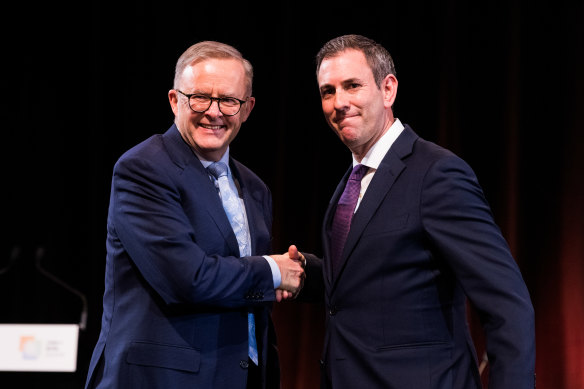This was published 2 years ago
Opinion
Redesign stage three tax cuts to better balance equity and efficiency
Steven Hamilton
EconomistThe stage three tax cuts have become enemy No.1 among Australia’s policy commentariat. Claims abound that they’ll turn Australia’s income tax into a flat tax (they won’t) and that scrapping them is the solution to our inflationary predicament (it isn’t).
Much of the discussion is ill-informed. Partly, that’s because tax policy experts haven’t done a good enough job explaining to the public how we ought to think about tax design.

Prime Minister Anthony Albanese and Treasurer Jim Chalmers still have time to redesign the stage 3 tax cuts.Credit: James Brickwood
The stage three tax cuts are, as the name suggests, the third in a series of tax cuts introduced by the former Coalition government. The first two stages offered targeted tax relief to low- and middle-income taxpayers and raised tax thresholds to offset bracket creep.
For the Coalition, it was high folly to hive off tax relief for high earners into a standalone package from 2024. While the three stages together might seem reasonable, stage three on its own is difficult to defend.
In my view, one part of stage three is defensible: raising the income at which the top marginal tax rate of 45 per cent begins to apply, from $180,000 to $200,000 a year. That threshold has remained unchanged since July 2008.
Over the past 14 years, nominal wages have risen by more than 40 per cent. With a fixed threshold, more and more people will find themselves in the top bracket even if their real wage hasn’t changed.

One part of the stage 3 plan is defensible, others less so.Credit: Gabriele Charotte
In an ideal world, the thresholds would automatically rise every year in line with inflation. In lieu of this, periodic increases are reasonable. I think an 11 per cent increase in the top threshold over 16 years is defensible.
The other two parts of stage three are harder to defend. To understand why, please step into the mind of a tax economist for a moment.
For more than half a century, economists have considered how we should set the tax schedule, carefully trading off efficiency and equity. The late Sir Jim Mirrlees, who would later win the Nobel prize in economics, formalised this in 1971.
Nearly three decades later in 1998, Peter Diamond (another Nobel prize winner) would make Mirrlees’ difficult-to-digest, highly mathematical contribution digestible. The intuition this would reveal about how we should set tax rates was remarkably simple and clear.
Marginal tax rates tend to confuse people. A marginal tax rate applies only to a marginal dollar of earnings (not all the earnings that came before it).
In Australia, that means nothing on the first $18,200 you earn, 19 per cent on the next $26,800, 32.5 per cent on the next $75,000, 37 per cent on the next $60,000, and 45 per cent on the rest. If I raise your marginal tax rate, that only changes the tax you pay on the dollars you earn in the tax bracket you’re in – the tax you pay on your earnings in the lower brackets is unchanged.
So lowering the marginal tax rate at a particular level of earnings has two effects: first, it increases the incentive to earn a marginal dollar for the people who have that level of earnings; and second, it hands free cash, with no change in marginal incentives at all, to everyone above that level of earnings.
And that’s where the stage three tax cuts run into trouble. People in the top bracket benefit from: the increase in the top threshold; the reduction in the 37 per cent rate to 30 per cent; and the reduction in the 32.5 per cent rate to 30 per cent. And yet, their marginal tax rate is unchanged at 45 per cent.
Given how hard it is to eke out incremental policy gains, it seems crazy to hand billions a year to a small group of people without improving their marginal incentives.
The trouble, of course, is figuring out how to lower tax rates (and thus improve incentives) at lower incomes without those benefits also accruing to higher earners, given that’s how marginal tax rates work. Well, there’s only one way to claw some money back, and that’s by simultaneously raising the marginal rate in the top bracket.
This can be done so higher earners still gain on net, just not as much as they otherwise would. We must accept that the cost of greater equity is somewhat lower efficiency. And note there are so many more in the 32.5 per cent bracket, whose incentives will improve, than in the 45 per cent bracket, whose incentives will diminish. That’s the game of optimal taxation.
I’m no raging communist, and yet I don’t look at today’s tax schedule and think it needs to become radically less progressive. I’m OK with the reduction in the 32.5 per cent rate to 30 per cent. But instead of dropping the 37 per cent rate to 30 per cent, it should remain at 37 per cent and instead the income at which it cuts in should rise to offset bracket creep. And the top rate should go up from 45 per cent to claw back some of those windfall gains.
Albanese and Chalmers still have three budgets to redesign stage three. They certainly can. And I suspect they will. A bit of “optimal taxation” can show them how.
Steven Hamilton is assistant professor of economics at George Washington University in Washington DC and visiting fellow at the Tax and Transfer Policy Institute at the ANU.
The Opinion newsletter is a weekly wrap of views that will challenge, champion and inform your own. Sign up here.